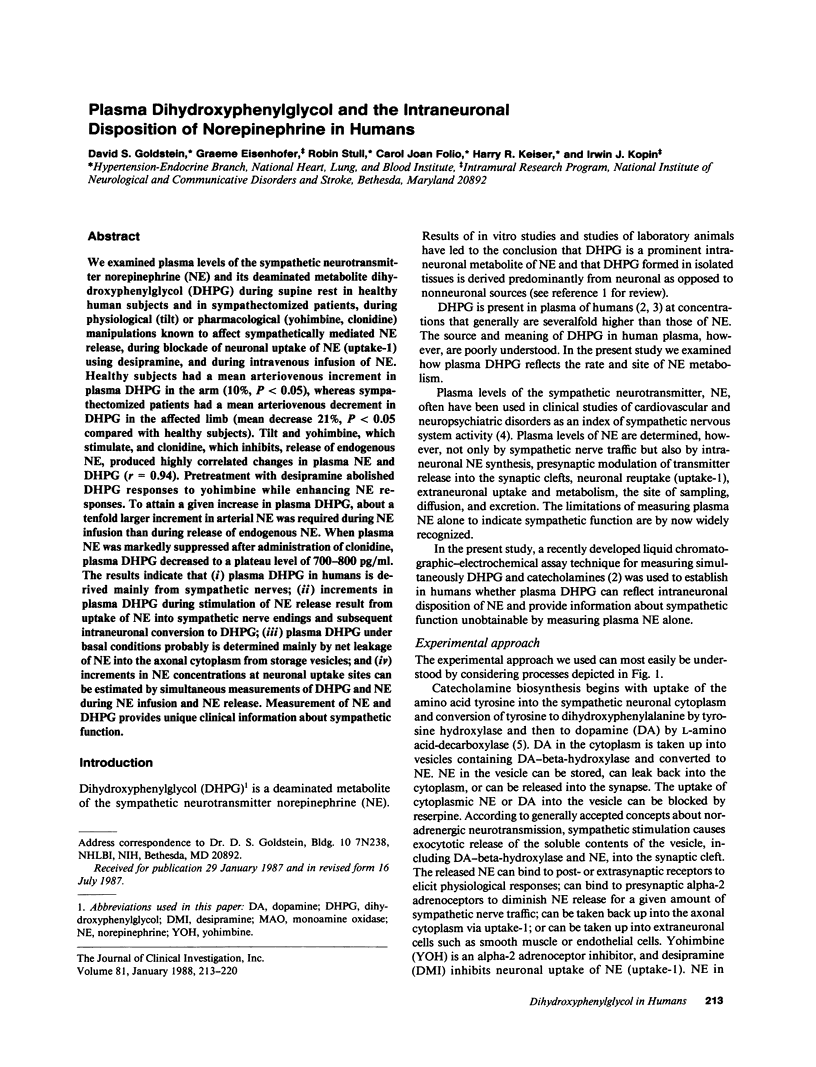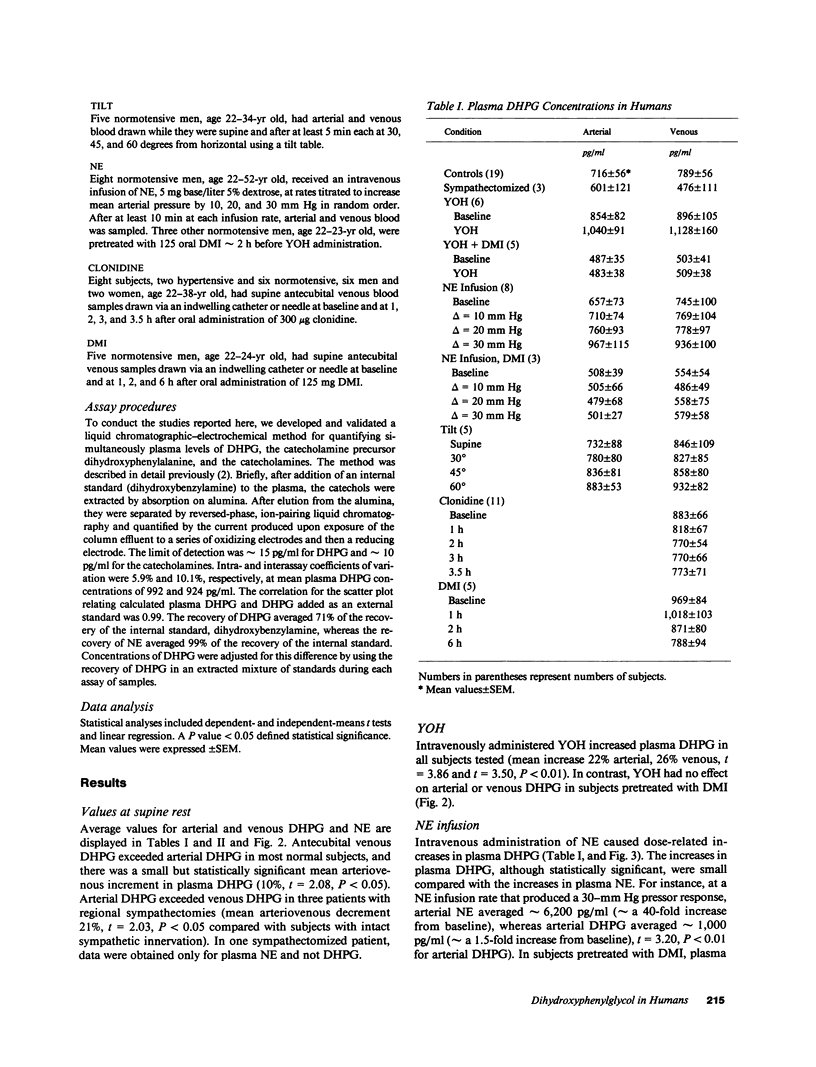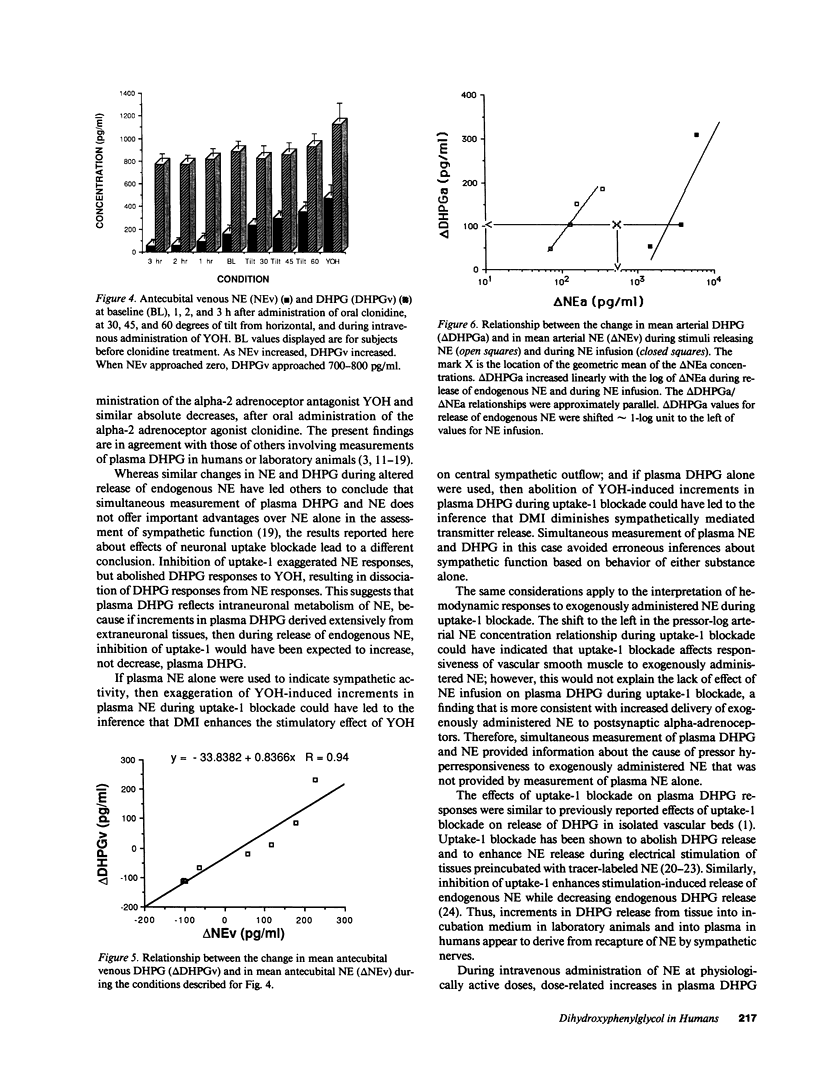Abstract
We examined plasma levels of the sympathetic neurotransmitter norepinephrine (NE) and its deaminated metabolite dihydroxyphenylglycol (DHPG) during supine rest in healthy human subjects and in sympathectomized patients, during physiological (tilt) or pharmacological (yohimbine, clonidine) manipulations known to affect sympathetically mediated NE release, during blockade of neuronal uptake of NE (uptake-1) using desipramine, and during intravenous infusion of NE. Healthy subjects had a mean arteriovenous increment in plasma DHPG in the arm (10%, P less than 0.05), whereas sympathectomized patients had a mean arteriovenous decrement in DHPG in the affected limb (mean decrease 21%, P less than 0.05 compared with healthy subjects). Tilt and yohimbine, which stimulate, and clonidine, which inhibits, release of endogenous NE, produced highly correlated changes in plasma NE and DHPG (r = 0.94). Pretreatment with desipramine abolished DHPG responses to yohimbine while enhancing NE responses. To attain a given increase in plasma DHPG, about a tenfold larger increment in arterial NE was required during NE infusion than during release of endogenous NE. When plasma NE was markedly suppressed after administration of clonidine, plasma DHPG decreased to a plateau level of 700-800 pg/ml. The results indicate that (i) plasma DHPG in humans is derived mainly from sympathetic nerves; (ii) increments in plasma DHPG during stimulation of NE release result from uptake of NE into sympathetic nerve endings and subsequent intraneuronal conversion to DHPG; (iii) plasma DHPG under basal conditions probably is determined mainly by net leakage of NE into the axonal cytoplasm from storage vesicles; and (iv) increments in NE concentrations at neuronal uptake sites can be estimated by simultaneous measurements of DHPG and NE during NE infusion and NE release. Measurement of NE and DHPG provides unique clinical information about sympathetic function.
Full text
PDF







Images in this article
Selected References
These references are in PubMed. This may not be the complete list of references from this article.
- Brandao F. Inactivation of norepinephrine in an isolated vein. J Pharmacol Exp Ther. 1977 Oct;203(1):23–29. [PubMed] [Google Scholar]
- Brandão F., Monteiro J. G., Osswald W. Differences in the metabolic fate of noradrenaline released by electrical stimulation or by tyramine. Naunyn Schmiedebergs Arch Pharmacol. 1978 Oct;305(1):37–40. doi: 10.1007/BF00497004. [DOI] [PubMed] [Google Scholar]
- Brown M. J. Simultaneous assay of noradrenaline and its deaminated metabolite, dihydroxyphenylglycol, in plasma: a simplified approach to the exclusion of phaeochromocytoma in patients with borderline elevation of plasma noradrenaline concentration. Eur J Clin Invest. 1984 Feb;14(1):67–72. doi: 10.1111/j.1365-2362.1984.tb00706.x. [DOI] [PubMed] [Google Scholar]
- Dennis T., Benkelfat C., Touitou Y., Auzeby A., Poirier M. F., Scatton B., Lôo H. Lack of circadian rhythm in plasma levels of 3,4-dihydroxyphenylethyleneglycol in healthy human subjects. Psychopharmacology (Berl) 1986;90(4):471–474. doi: 10.1007/BF00174063. [DOI] [PubMed] [Google Scholar]
- Dubocovich M. L., Langer S. Z. Influence of the frequency of nerve stimulation on the metabolism of 3H-norepinephrine released from the perfused cat spleen: differences observed during and after the period of stimulation. J Pharmacol Exp Ther. 1976 Jul;198(1):83–101. [PubMed] [Google Scholar]
- Eisenhofer G., Goldstein D. S., Stull R., Keiser H. R., Sunderland T., Murphy D. L., Kopin I. J. Simultaneous liquid-chromatographic determination of 3,4-dihydroxyphenylglycol, catecholamines, and 3,4-dihydroxyphenylalanine in plasma, and their responses to inhibition of monoamine oxidase. Clin Chem. 1986 Nov;32(11):2030–2033. [PubMed] [Google Scholar]
- Eisenhofer G., Goldstein D. S., Stull R., Ropchak T. G., Keiser H. R., Kopin I. J. Dihydroxyphenylglycol and dihydroxymandelic acid during intravenous infusions of noradrenaline. Clin Sci (Lond) 1987 Jul;73(1):123–125. doi: 10.1042/cs0730123. [DOI] [PubMed] [Google Scholar]
- Elsworth J. D., Roth R. H., Redmond D. E., Jr Relative importance of 3-methoxy-4-hydroxyphenylglycol and 3,4-dihydroxyphenylglycol as norepinephrine metabolites in rat, monkey, and humans. J Neurochem. 1983 Sep;41(3):786–793. doi: 10.1111/j.1471-4159.1983.tb04809.x. [DOI] [PubMed] [Google Scholar]
- Endo T., Starke K., Bangerter A., Taube H. D. Presynaptic receptor systems on the noradrenergic neurones of the rabbit pulmonary artery. Naunyn Schmiedebergs Arch Pharmacol. 1977 Feb;296(3):229–247. doi: 10.1007/BF00498689. [DOI] [PubMed] [Google Scholar]
- Goldstein D. S., Bonner R. F., Zimlichman R., Zahn T. P., Cannon R. O., 3rd, Rosing D. R., Stull R., Keiser H. R. Indices of sympathetic vascular innervation in sympathectomized patients. J Auton Nerv Syst. 1986 Apr;15(4):309–318. doi: 10.1016/0165-1838(86)90017-2. [DOI] [PubMed] [Google Scholar]
- Goldstein D. S., Horwitz D., Keiser H. R., Polinsky R. J., Kopin I. J. Plasma l-[3H]norepinephrine, d-[14C]norepinephrine, and d,l-[3H]isoproterenol kinetics in essential hypertension. J Clin Invest. 1983 Nov;72(5):1748–1758. doi: 10.1172/JCI111134. [DOI] [PMC free article] [PubMed] [Google Scholar]
- Goldstein D. S., Levinson P. D., Zimlichman R., Pitterman A., Stull R., Keiser H. R. Clonidine suppression testing in essential hypertension. Ann Intern Med. 1985 Jan;102(1):42–49. doi: 10.7326/0003-4819-102-1-42. [DOI] [PubMed] [Google Scholar]
- Goldstein D. S., McCarty R., Polinsky R. J., Kopin I. J. Relationship between plasma norepinephrine and sympathetic neural activity. Hypertension. 1983 Jul-Aug;5(4):552–559. doi: 10.1161/01.hyp.5.4.552. [DOI] [PubMed] [Google Scholar]
- Goldstein D. S., Zimlichman R., Stull R., Folio J., Levinson P. D., Keiser H. R., Kopin I. J. Measurement of regional neuronal removal of norepinephrine in man. J Clin Invest. 1985 Jul;76(1):15–21. doi: 10.1172/JCI111939. [DOI] [PMC free article] [PubMed] [Google Scholar]
- Goldstein D. S., Zimlichman R., Stull R., Keiser H. R., Kopin I. J. Estimation of intrasynaptic norepinephrine concentrations in humans. Hypertension. 1986 Jun;8(6):471–475. doi: 10.1161/01.hyp.8.6.471. [DOI] [PubMed] [Google Scholar]
- Howes L. G., Hawksby C. C., Reid J. L. Comparison of plasma 3,4-dihydroxyphenylethylene glycol (DHPG) and norepinephrine levels as indices of sympathetic activity in man. Eur J Clin Invest. 1986 Feb;16(1):18–21. doi: 10.1111/j.1365-2362.1986.tb01301.x. [DOI] [PubMed] [Google Scholar]
- Howes L. G., MacGilchrist A., Hawksby C., Sumner D., Reid J. L. An improved approach for the determination of plasma [3H]noradrenaline kinetics using high-performance liquid chromatography. Clin Sci (Lond) 1986 Aug;71(2):211–215. doi: 10.1042/cs0710211. [DOI] [PubMed] [Google Scholar]
- Izzo J. L., Jr, Greulich D. Radioenzymatic assay for plasma dihydroxyphenylglycol (DHPG), dihydroxymandelic acid (DOMA) and dihydroxyphenylacetic acid (DOPAC). Life Sci. 1983 Aug 1;33(5):483–488. doi: 10.1016/0024-3205(83)90798-1. [DOI] [PubMed] [Google Scholar]
- Izzo J. L., Jr, Thompson D. A., Horwitz D. Plasma dihydroxyphenylglycol (DHPG) in the in vivo assessment of human neuronal norepinephrine metabolism. Life Sci. 1985 Sep 16;37(11):1033–1038. doi: 10.1016/0024-3205(85)90593-4. [DOI] [PubMed] [Google Scholar]
- Johnston J. P. Some observations upon a new inhibitor of monoamine oxidase in brain tissue. Biochem Pharmacol. 1968 Jul;17(7):1285–1297. doi: 10.1016/0006-2952(68)90066-x. [DOI] [PubMed] [Google Scholar]
- Kopin I. J. Catecholamine metabolism: basic aspects and clinical significance. Pharmacol Rev. 1985 Dec;37(4):333–364. [PubMed] [Google Scholar]
- Kopin I. J., Zukowska-Grojec Z., Bayorh M. A., Goldstein D. S. Estimation of intrasynaptic norepinephrine concentrations at vascular neuroeffector junctions in vivo. Naunyn Schmiedebergs Arch Pharmacol. 1984 Apr;325(4):298–305. doi: 10.1007/BF00504372. [DOI] [PubMed] [Google Scholar]
- Li P. P., Warsh J. J., Godse D. D. Further characterization of brain 3,4-dihydroxyphenylethyleneglycol (DHPG) formation: dependence on noradrenergic activity and site of formation. Naunyn Schmiedebergs Arch Pharmacol. 1986 Jan;332(1):26–33. doi: 10.1007/BF00633193. [DOI] [PubMed] [Google Scholar]
- Li P. P., Warsh J. J., Godse D. D., Guttman M. Studies on the utility of urinary 3,4-dihydroxyphenylethylene-glycol (DHPG) measurement. Prog Neuropsychopharmacol Biol Psychiatry. 1985;9(5-6):717–720. doi: 10.1016/0278-5846(85)90047-8. [DOI] [PubMed] [Google Scholar]
- Maas J. W., Landis D. H. The metabolism of circulating norepinephrine by human subjects. J Pharmacol Exp Ther. 1971 Jun;177(3):600–612. [PubMed] [Google Scholar]
- Mishima S., Miyahara H., Suzuki H. Transmitter release modulated by alpha-adrenoceptor antagonists in the rabbit mesenteric artery: a comparison between noradrenaline outflow and electrical activity. Br J Pharmacol. 1984 Oct;83(2):537–547. doi: 10.1111/j.1476-5381.1984.tb16518.x. [DOI] [PMC free article] [PubMed] [Google Scholar]
- Mizukoshi M., Hano T., Kuchii M., Nishio I., Masuyama Y. Plasma noradrenaline and its deaminated metabolites in essential hypertension and pheochromocytoma. Jpn Circ J. 1985 Sep;49(9):1035–1042. doi: 10.1253/jcj.49.1035. [DOI] [PubMed] [Google Scholar]
- Robinson D. S., Johnson G. A., Nies A., Corcella J., Cooper T. B., Albright D., Howard D. Plasma levels of catecholamines and dihydroxyphenylglycol during antidepressant drug treatment. J Clin Psychopharmacol. 1983 Oct;3(5):282–287. [PubMed] [Google Scholar]
- Zavadil A. P., 3rd, Ross R. J., Calil H. M., Linnoila M., Blombery P., Jimerson D. C., Kopin I. J., Potter W. Z. The effect of desmethylimipramine on the metabolism of norepinephrine. Life Sci. 1984 Sep 3;35(10):1061–1068. doi: 10.1016/0024-3205(84)90070-5. [DOI] [PubMed] [Google Scholar]




